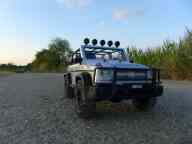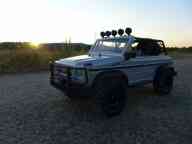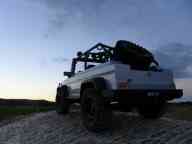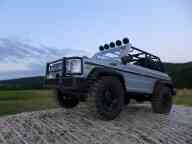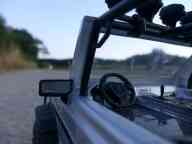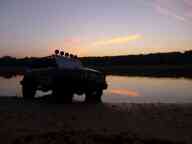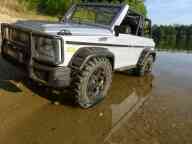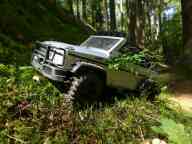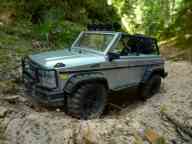RC 4x4 models (EN)
Heng Guan P402
2015-08-03: Heng Guan P402
Regular visitors of my weblog are surely used to reports from expeditions and scale model shows, that we do and visit with our scale model of Tatra 130. Bigger RC expedition vehicles of scale 1/10 usually form a kind of background and sometimes represent a real threat to our beautiful Tatras.
Today it will be something completely different. I received for review an expedition vehicle called Heng Guan P402 from the GearBest e-shop .
The car shall most certainly imitate the look of a Mercedes G63. It looks much like a real 4x4 SUV you may encounter en-route. From the very beginning I was curious if it would be possible to drive it that way too.
So take this review more like an impression. When I received the package, I really didn't expect too much. After the first miles off-road I had to change my point of view ;) . But first things first.
The car came very well packed. I was pleasantly surprised that everything was set and ready to go. No complicated set-ups. Just put the batteries inside and go. Please note, that 4 standard AA batteries for the remote control device are not included.
After unpacking, I inspected the car in detail how it is actually made. I know these RC expedition 4x4's only superficially and I have never driven them for more than a few seconds, so I was curious what's under the hood. The body is made of Lexan, it is very light and durable. It is mounted on 4 plastic rods and fixed by metal couplers. An accessory kit is included – a set of stickers, a light ramp designed to put LEDs inside (LEDs and wires not included).
The chassis is made of durable plastic too. It is an all-time 4x4 without differentials (or one can say locked diffs). Basically it almost reflects reality – Mercedes G has inter-axle and axle diff locks (which I miss the most on my Land Rover Discovery II). And frame chassis bend in terrain and so does the model – this is not a Tatra with central backbone tube chassis which is more rigid, than regular truck vendors can even think of :) . Even the cardan shafts and crosses are made of plastic, so we'll see, how long it can last in terrain.
The package includes 3 diameters of gearings for the electric motor. Of course, I chose the slowest gears, I love to crawl slowly and enjoy the functioning chassis. I just missed a hex key to loose screws on the motor.
Beware of open transfers between the motor and gearbox. On the motor, there is an alloy cast pinion, but the other wheel is made of plastic. Some deep wading or sand might cause dust getting between the teeth and damage the plastic gear. If that happens, you can always order a new set or 3D print your own gears or even some plastic case to protect the gears :) . The plastic gear is not a bad solution though, it reduces the noise of the gears.
The car's battery is of normal size, as we are used to. It is a 7.4V LiPol 1500mAh. So it is interchangeable with the high capacity NiMH I use in my Tatra. The vendor states, that the driving time on the supplied battery is approx. 16 minutes, which is interestingly short (at least for me). That's why I took directly my 5000mAh battery for the first trip. However, it has an interesting consequence – my NiMH battery is more than two times heavier than the original one.
It took me a while before figuring out what are the C-shaped parts for. They are shim washers under the coil spring to make them harder. That's what I was looking for – to heighten the rear axle, so the rear wheels wouldn't scrape the car's body.
My fast battery charger works with LiPol batteries fine. But there is a simple charger supplied in the package too. It looks rather like a constant current transformer which I'm afraid to put LiPol battery on (beware of over-charging). But maybe I'm wrong, it has a special 3-wire connector – may be to communicate somehow with the LiPol battery. Unfortunately I couldn't find anything about the supplied charger.
Let's drive!
Please note – before powering up, please make sure, your transmitter device has all controls completely in the zero positions, as the car we will always remember the controls' positions as zero on start-up. If you accidentally hold "forward" while powering-up the car, it will only go backwards. Please adjust steering trim only after start-up as it may do the same to steering. This is not a bug, this is a clever and stable solution.
As I've already written, the P402 is an all-time 4x4, which also means the turning diameter is pretty large. Using a freshly charged 5000mAh NiMH battery, the car was driving continuously for almost 2 hours. That's a good result, even though this amount of energy makes my Tatra 130 drive for more than 4 hours :) . Yes, the P402 is a bigger "beast" and I was driving quite fast.
How does it feel driving?
Yes, driving is easy ! The car can do flat-out starts, instant breaking, jumping like a frog, turns like a formula one... some people love to drive this way and the car is capable of that, no doubt about it. There are many videos of this kind on the web...
But would you drive your real Mercedes G63 like that? I guess you wouldn't and that's what I wanted to find out – if one can drive the P402 as smoothly as a real thing. I'm very much used to my CPU-controlled Tatra 130. It took me quite a long time to force the electric motor to behave smoothly in almost any condition. Well, I really didn't expect the P402 having anything even remotely comparable to my Tatra 130. The P402 comes with a standard RC-car transmitter, or remote control device if you wish. It has a two-way lever for forward-backward (not gas-brake, or even gear shift as my Tatra :) ) and a steering wheel. Many people are used to these transmitters, but I never liked them too much, I prefer helicopter transmitters as I can feel the control better.
So only the driver – me – will be in charge – the car will drive as smoothly, as I'm capable of gently pressing the very sensitive throttle stick :) . Let's find out...
2015-08-06: First real off-road test
The bodywork is not tightly mounted on the chassis, so it rattles in some conditions. This is a normal behaviour of many other RC cars of this class. One get's used to it, it's not a noise representing a problem :) .
On the first gear, the car runs at approx. 6 km/h at full throttle. The second gear is about two times faster. After a few hundred meters the gears got significantly more silent and softer. The car does not hold still on a steep hill very much any more :) .
When we returned from our first test drive, a family drove by on bicycles. The children liked the P402 very much, they would certainly welcome it as a Christmas or birthday gift. I'd recommend that ;) .
The P402 handles off-road terrain nicely. If one cares just a little bit about the drive and enjoys the capabilities of the 4x4, the drive is very nice and entertaining and one does not need to worry about any damage to the car. Of course, long jumps and hard driving won't do any good to the chassis and can possibly damage it. So far it has not yet happened, but I'm not into trying it ;) .
Conclusion
I must say I fell in love with the car after a few test runs. It goes well, common obstacles on the road with can be crossed with ease, a branch or a stone does not matter, unless you want to enjoy a realistic drive through terrain obstacles. It is also a fast race car, built in such a way that a few scratches and somersaults should not matter. That's something I like the most about this car – its variability. The car is able to provide both – unbridled fun – blazing fast "flight" through terrain, as well as slow and realistic (almost scale-model) off-road driving experience. And it even looks surprisingly quite good.
I think the P402 can be a great companion on the beach, forest or any other trip you might think of. And even when the battery is dead, the P402 is quite a light vehicle to carry ;) .






